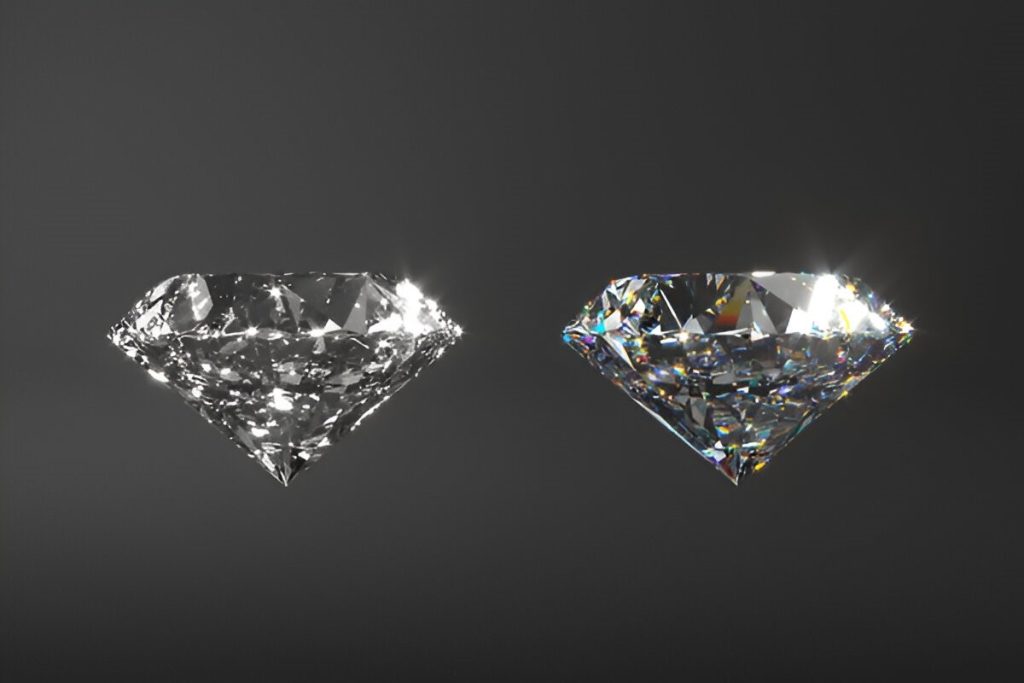Channel your inner Vogue and Confidence!

Diamonds are some of the world’s most beautiful and rare gemstones, and buying a diamond can hold great significance to many people. So, whether it’s love, commitment, or something else, you need to be sure the diamond you’re buying is real.
Unfortunately, many people are scammed with fake diamonds these days. With so many imitation and synthetic diamonds available in the market, telling a real diamond from a fake one is rather challenging.
So, how do you know you’ve got the real thing?
A big part of this journey is familiarising yourself with a diamond’s structure and other accompanying components to differentiate a fake from a real one. Thus, before we offer our opinions on how to spot a fake diamond, let’s first understand its characteristics.

Natural diamonds are formed in the Earth’s mantle after carbon-containing materials are subjected to extreme heat and pressure for billions of years. As a result, each diamond is unique, with variations in size, clarity and color that give it its own identity.
Natural diamonds are formed without any form of human intervention, so they are cherished for their rarity and appeal. Although they come with a higher price tag due to the cost of extraction and mining, they hold a special appeal to those seeking a rare and timeless symbol of love.
As the name suggests, lab-grown diamonds are produced in a controlled laboratory environment rather than being mined from the Earth. These diamonds are crafted using cutting-edge technology that replicates the natural conditions required for diamond formation.
The Lab-grown diamonds possess the same composition, physical characteristics, and crystal structure as natural diamonds and, hence, have the same kind of sparkle and luster. Moreover, because they’re created in a controlled environment, you can find them in a wide range of shapes, sizes, and colors to suit your preferences, style, and budget.
Diamonds, like all gemstones, are relatively easy to fake. The most common materials used are cubic zirconia and glass. Other synthetic stones, such as synthetic cubic zirconia, yttrium aluminum garnet, gadolinium gallium garnet, and moissanite, are also used to create fake diamonds.
Forgers make these diamond substitutes appear extremely convincing to trick the average consumer. Diamonds made from these materials are cheap and easy to produce, ensuring they’re easily appealing to inexperienced buyers.
Does that mean you can never possibly identify the fake ones when buying new or pre-owned diamond rings or any other diamond jewelry?
Not really. Backed with the right knowledge, you can easily spot a fake from a real one.
Thankfully, there are several ways in which people can check the authenticity of diamonds.
Here are eight ways to do so
Diamond testers are handheld devices that differentiate between real and artificial diamonds using thermal conductivity. These devices test the rate at which heat is conducted through the gemstone, with real diamonds showcasing higher thermal conductivity than most types of fake.
However, diamond testers do not distinguish between natural and lab-grown diamonds. They will only detect cubic zirconia, white sapphire, and moissanite.
There is a way to tell real diamonds from imitations because some of them shine when exposed to ultraviolet light. When exposed to UV light, real diamonds glow, whereas replicas are quiet.
Use a jeweler’s loupe (small magnifying glass) to check the diamond’s internal and external characteristics, similar to a diamond’s origin. It is real if the diamond has blemishes, inclusions or any growth patterns. Synthetic and imitation diamonds lack the detailing typical of natural diamonds.
Take a glass of water and put the diamond in it. A real diamond will sink to the bottom of the glass as it’s denser and highly refractive. On the other hand, a fake diamond will either float or act differently.
If you’re too serious about ascertaining the genuinity of your diamond, put it through a fire test. Use a lighter to light the stone for around 30 seconds before dropping it in cold water. If the diamond is real, it will remain intact; if not, it will break into pieces. This is because weaker materials cannot withstand the rate at which the materials expand and contract due to the heat.
Assess diamond’s refractivity using a newspaper. Simply place flat surface of the diamond on a page with legible writing to do this test. Make sure lighting is adequate and no items or people are casting shadows. If you can read the letters, the stone is fake, even though they are not very clear.
You can’t look through a real diamond since its facets would reflect light in different directions and you can’t lead the letters on the newspaper.
Place a white piece of paper on the ground or a flat surface and draw a small dot. Lay the diamond onto the dot with the flat surface down. Now, through the pointed end of the diamond, try to look down onto the paper. It is fake if you notice a circular reflection within the stone. It is difficult to observe the dot’s round reflection because of a genuine diamond’s high refractive index.
The diamond should be placed between your two fingers. Then take a breath. A small layer of fog forms on the diamond from the heat and moisture of your breath. If the fog disappear instantly then diamond is real. It’s probably a fake diamond though if it takes a few seconds to clear. Diamonds disperse heat rapidly. This is because they are highly efficient heat conductors.
The tests and methods mentioned and discussed in this article can help you ascertain its authenticity whether you’re buying new or pre-owned jewelry. But consulting a jeweler who can offer a more precise evaluation is the best method to determine if a diamond is real or phony.
You can make wise decisions and make sure your investment is authentic and valued by understanding the difference between real and imitation diamonds.

The Fashion and Style enthusiast with a flair for drama and entertainment! A millennial on the lookout for the trending styles inspired by and believes in: “You can get anything in life if you have the right dress for it!” Adding a little magic through the power of words and not holding back on fashion and styling opinions! Let’s connect to stay on top of trend alerts and the who is who of Fashion world and get inspired to give your personality the styling oomph you’ve been craving for! Nageen Abbas at Vogue Vocal is the brains behind our Woke Vogue and Lifestyle Library!